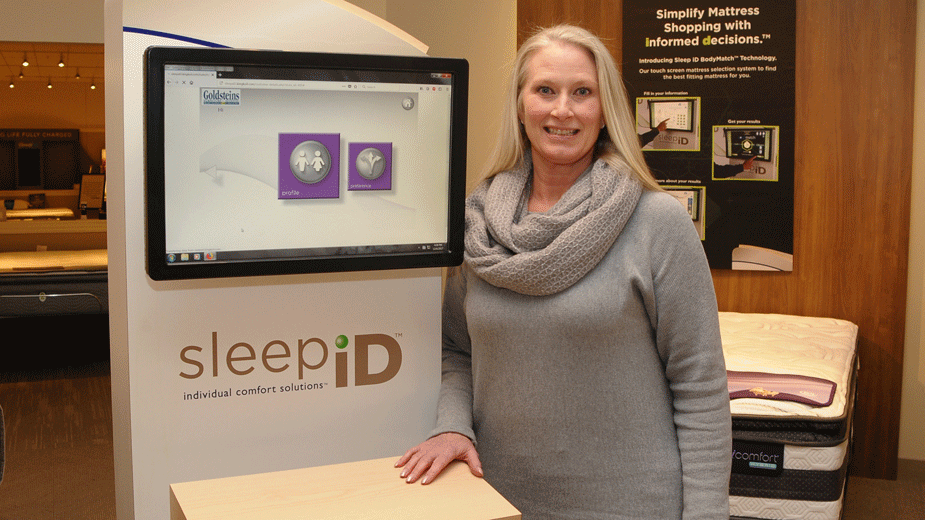Your Good Health Rests on Your Mattress
YOUNGSTOWN, Ohio – How consumers once selected a mattress for their beds often was determined by two factors: price and comfort.
While those two elements still influence buyers, new trends and technology have helped customers – especially baby boomers – to consider other features that could have a long-term effect on their health. In short, the public is beginning to realize that if they want a solid night of rejuvenating sleep, their mattress matters.
“We think it’s very important,” says John Coey, merchandise manager at Goldsteins Furniture & Bedding, based in Hermitage, Pa., which has stores in Boardman and Niles. “Not many of us get eight hours of sleep anymore, but if we get at least six, it better be the best six.”
The mattress on which one sleeps is a major factor in how well one sleeps and could affect a person’s health. For example, in a poll of 1,500 randomly selected people, the National Sleep Foundation found that 92% of those ages 25 to 55 responded that a comfortable mattress is important to a good night’s sleep. Moreover, sleeping on the wrong mattress – or an older mattress – could aggravate back or neck pain and affect an individual’s sleep patterns and productivity during the day.
A study in the Journal of Chiropractic Medicine seven years ago showed that a sample group of men and women experienced much less back pain, slept better and had less stress after they switched to a new medium or firm mattress.
According to that study, the new bedding systems reduced back pain by 48% across the sample group and improved their quality of sleep by 55%. And these improvements led to an overall decrease in stress, the study showed.
Over the last seven years, Coey says, the sales staff in Goldsteins’ sleep department has incorporated a diagnostic element when customers inquire about a new mattress. “It’s not just about price,” he says. “There’s got to be more of a thought process put into this.”
Consumers once bought mattresses based on how comfortable they deemed them. While comfort might help a person fall asleep, it might not be enough to contribute to a solid night’s rest. The real game-changer in the mattress business is the support that proper bedding provides.
“It’s an important factor,” Coey says. “Once you’re asleep, is your body receiving the support and alignment it needs?”
Thus, it’s imperative to assess each customer and determine the mattress that works best for him. “It’s obvious that there’s not one mattress that will serve everybody,” Coey says. “We can determine what kind of support they need by assessing size and weight.”
Once the short diagnostic is completed, the information is used to whittle down the number of options for the customer from the 45 or so bedding systems that Goldsteins sells.
Customers have responded favorably to the attention they receive through the process, Coey says. “When we started the diagnostics, about 18% of our business was in bedding. The industry standard is 14% [for furniture retailers],” he says. “Today, it’s 25% of our volume.”
U.S. mattress sales generate about $7 billion in revenue each year, according to data published by research organization Statistic Brain. Data show that 36 million mattresses are shipped to customers annually and the industry employs 20,570 people nationwide.
While new technology such as memory foam and inner-spring/foam hybrid mattresses make gains each year in the market, the vast majority of buyers still flock to traditional inner-spring bedding. These beds still command about 90% of the market today, statistics show.
Customers are beginning to pay more attention to how their mattress affects their sleep and overall health, confirms Drew Carchedi, general manager of Sleepy Hollow Sleep Shop, a local mattress and bedding franchise with stores in Boardman, Howland, Hermitage and Austintown.
More and more, mattress manufacturers are incorporating the latest technology into their product, Carchedi says. Among these enhancements are innovations such as Sleeptracker, a feature that can convert any bed into a “smart” bed.
“It’s a virtual sleep coach, very similar to Fitbit technology,” Carchedi says. The Sleeptracker, marketed by BeautyRest, is an accessory that is wired underneath the mattress and can be modified on just about any mattress. The system monitors sleep habits and reads vitals such as heart rates, snoring, and calculates the amount of REM sleep during the night.
“You can download an app to your phone or iPad,” and monitor sleep through readings displayed on these devices, Carchedi says.
Materials in mattresses have improved along with technology, Carchedi says as manufacturers such as Tempur-Pedic have had an impact on the entire industry over the last two decades. “It’s really changed the game,” he says. The company pioneered the foam technology NASA uses that aligns itself with body contours.
Still, many customers feel that all-foam mattresses grip the body too snugly and make it too difficult to move off the bed. For these customers, companies have developed a hybrid foam/inner-spring mattress that provides an adequate balance of foam comfort and inner-spring support.
“What we try to do is diagnose their sleep needs,” Carchedi says. Those who suffer from sleep apnea and snoring, for example, could need an adjustable base to help them achieve a better night’s sleep.
“There’s such a surge in the mattress market,” Carchedi says. “We’re not just selling sleep, but concentrating on whole wellness and health.”
Pictured: “Smart” mattresses can help identify sleep issues, says Kristen Colley of Goldsteins Furniture & Bedding.
Copyright 2024 The Business Journal, Youngstown, Ohio.



